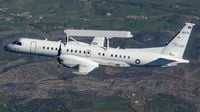On the evening of May 8, 2025, tensions between India and Pakistan escalated dramatically as Pakistan initiated a drone and missile attack targeting several Indian cities. This unprovoked assault was met with a fierce and immediate counter-response from India, which not only neutralized the incoming threats but also inflicted significant damage on the Pakistan Air Force.
In a decisive act of retaliation, India successfully shot down a Pakistan Air Force AWACS (Airborne Warning and Control System) aircraft within Punjab province. This marked a critical blow to Pakistan, which relies heavily on these advanced surveillance systems for air defense and situational awareness.
The incident unfolded as Pakistan launched drones and missiles towards border states, including Jammu and Kashmir, Rajasthan, and Punjab. The Indian Army reported that all drones involved in the attack were neutralized, and fortunately, no casualties were reported on the Indian side. However, the Pakistani forces suffered considerable losses, with at least three of their fighter jets, including one F-16 and two JF-17 aircraft, being shot down during the ensuing conflict.
AWACS aircraft play a vital role in modern warfare, serving as airborne command and control centers that enhance situational awareness and coordinate air operations. Equipped with large radar domes, these aircraft can detect, track, and identify air and surface contacts over vast distances, providing real-time information to ground and air forces. The AWACS system is crucial for early threat detection, allowing military forces to respond swiftly to potential incursions before they reach national airspace.
Pakistan currently operates nine AWACS systems, which include the Saab-2000 Erieye and the ZDK-03 models. The Erieye, in particular, is known for its extensive surveillance capabilities, covering a radius of over 500,000 square kilometers horizontally and reaching altitudes of over 60,000 feet. This aircraft can detect and track a wide range of targets, from fighter jets to smaller objects like Jet Skis, making it an invaluable asset for maintaining air superiority.
The Saab-2000 Erieye, which Pakistan ordered from Sweden in 2006, boasts an endurance of over nine hours and a range exceeding 2,000 nautical miles (3,705 kilometers). Its advanced radar system allows for rapid detection and tracking of objects, providing critical information to military commanders. However, with the recent retirement of the Chinese ZDK-03 AWACS, the aircraft shot down by India could very well have been a Saab-2000 Erieye.
In contrast, the Indian Air Force (IAF) operates five AWACS aircraft, which include three Israeli EL/M-2090 Phalcon systems mounted on Russian IL-76 A-50E/I jets, and two Netra Mk-1 systems on Brazilian Embraer business jets. The IAF's investment in these advanced systems reflects India's commitment to enhancing its aerial defense capabilities amidst ongoing regional tensions.
The events of May 8 have drawn international attention, with calls for de-escalation coming from various quarters, including the United States. U.S. officials have urged both nations to exercise restraint and seek diplomatic solutions to their conflicts.
As the situation continues to develop, both countries remain on high alert, with military operations ongoing. The rapid escalation of hostilities highlights the fragile nature of peace in the region and the critical need for dialogue to prevent further conflict.
In summary, the shooting down of Pakistan's AWACS aircraft represents a significant moment in the ongoing military tensions between India and Pakistan. It underscores the importance of advanced surveillance systems in modern warfare and the potential for rapid escalation in conflicts fueled by regional rivalries. As both nations navigate this precarious situation, the international community watches closely, hoping for a resolution that avoids further bloodshed.

